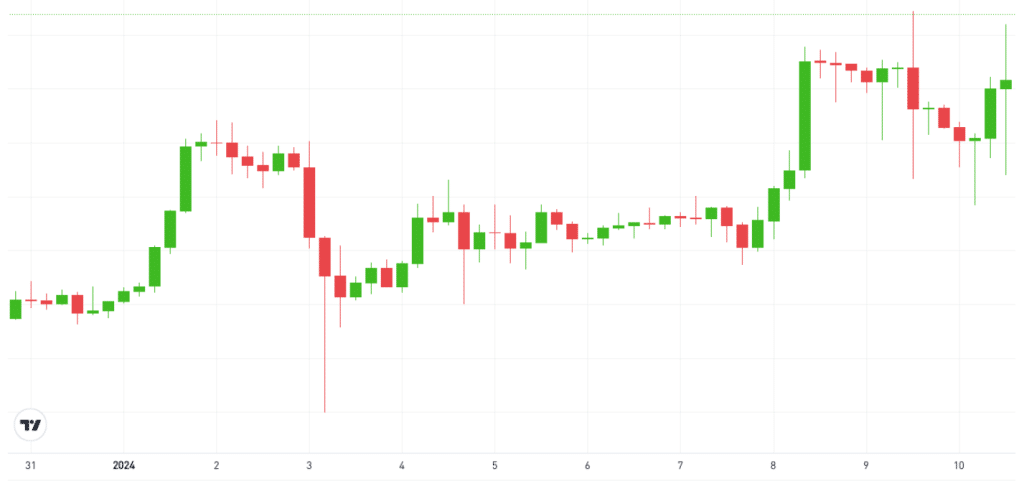Why Is Crypto Down Today?
As of this writing, crypto prices are up slightly. However, given recent gains, that could change quickly. Later today, the question could instead be, “Why is crypto down today, or why is Bitcoin crashing?” It’s a whipsaw world we trade in, and crypto markets trade up or down for a number of reasons.
Just this week, crypto markets have seen euphoria, profit-taking, and even some liquidations for leveraged trades. In this article, we’ll explore the possible reasons for a Bitcoin drop or crypto crash within the context of current crypto happenings. Curious to know why the cryptocurrency market is down today or asking, “Why did Bitcoin crash?” Let’s find out.
Why Did the Cryptocurrency Market Crash Today?
The most recent crypto crash relates to the spot Bitcoin exchange-traded funds (ETFs) which were recently approved by the US Securities and Exchange Commission (SEC). ETFs offer an easy way for investors to gain portfolio exposure to Bitcoin (BTC) and are expected to increase demand for BTC.
Prior to approval, Bitcoin saw a price runup, climbing 18% in a month from $41,229 to $48,644 — but not without some dips along the way.
During the runup, Matrixport, a crypto financial services platform, published an article suggesting that the SEC would reject the broadly anticipated Bitcoin ETFs. That was on Jan 3, with many suggesting the article led to the selloff marked with a red candle below.

It’s possible that the article dampened hopes in an ETF hype-fueled rally. However, it’s likely that leverage played a larger role in the selloff. Leverage allows traders to take on larger bets, in this case, using Bitcoin as collateral. Small market moves can lead to big selloffs for traders on the wrong side of the market, causing liquidations that add to selling pressure.
Later, on January 9th, Bitcoin sold off again, this time following a post from the SEC account on the X platform. The post announced SEC approval of Bitcoin ETFs, but the SEC quickly responded, stating that the SEC’s X account had been hacked and that the news was not true. Late on January 10th, the SEC voted to approve 11 pending Bitcoin spot ETF applications. BTC’s price suffered during the uncertainty of the day.
Bitcoin, as the largest cryptocurrency by market capitalization, often leads the rest of the market up or down. Why is crypto down this time? Often, it’s related to a Bitcoin drop. Cryptocurrencies trade on their independent fundamentals and news events, but Bitcoin still sways the broad market.
Why is Bitcoin Down Today?
Following two Bitcoin crashes less than a week apart, the Bitcoin market resumed an upward trajectory. But will it last? Bitcoin’s 2023 gains of over 150% give reason to expect some profit-taking in the new tax year. While the SEC approvals weren’t a “sell the news” event, a pullback should be expected.
Recent investors taking profit likely pose the most risk to Bitcoin price action, with a reported $1.3 billion in BTC sent to exchanges, according to Glassnode stats. Moving crypto from self-custody wallets to exchanges could indicate future selling pressure.
What Forces Influence Crypto Prices?
Crypto markets can move on a dime, switching from uptrends to sudden drops without warning. Part of the challenge lies in market size. The industry’s relative youth and smaller market capitalization make it more volatile. The entire crypto market recently topped $1.8 trillion, more than a trillion dollars smaller than Apple (AAPL). As the market evolves, several factors can influence prices going forward.
Supply and Demand
Like all markets, crypto prices answer to the timeless forces of supply and demand. If supply outpaces demand, prices fall. When demand exceeds supply, prices rise as buyers compete for purchases. Market-leading cryptocurrencies Bitcoin and Ethereum both benefit from limited supplies. Bitcoin is programmatically limited to 21 million bitcoins. Ethereum’s supply, while not hard coded, employs a burning mechanism that reduces supply while the consensus protocol mints new ETH. The result has proven to be slightly deflationary.
If long-term demand remains high for these two coins, prices should also increase.
Fundamentals
Crypto fundamentals often use different measures compared to stocks, for example, but seem to answer the same question: “What is it worth?”
Investors consider several metrics, including:
- Adoption rates: BTC as well as ETH, to a lesser degree, are now household names, largely due to their usage. Both blockchain networks see wide usage across the globe, adding to the “network effect” that makes these assets valuable. Changes in usage and adoption rates can affect prices.
- Transaction volume: Along with adoption rates, transaction volume plays a vital role in coin and token prices. In addition, total value locked (TVL), a measurement of activity on smart-contract blockchains, becomes an important fundamental measurement that can affect prices.
- Revenue: Mining or staking revenue reflects the health of the network by ensuring decentralized participation in consensus when revenues are strong. In proof-of-stake networks, investors can share in these yields.
- Yields: Beyond proof-of-stake yields, certain crypto tokens act as a “key” to earn yields on decentralized protocols.
- Network security and technology: Bitcoin derives its value from its scarcity, decentralization, and the network’s security. The technology behind a given cryptocurrency leads investors to either embrace or eschew the protocol, ultimately reflecting in the price.
Macro Influences
External factors like interest rates or inflation can affect crypto prices. Bitcoin’s price, in particular, responded to changes in both because many investors see BTC as a hedge against inflation.
Sentiment
Like other trading markets, the crypto market goes through bull and bear cycles. When market sentiment is bearish, prices can trade sideways or down before reaching a turning point.
Technicals
Chart technicals often play a large role in trading, now magnified by automated trading. Traders worldwide make trading decisions based on technical indicators, which, in a relatively small market, can create a self-fulfilling prophecy.
Is Cryptocurrency Safe to Invest in?
Cryptocurrency comes with price risks, as detailed earlier. However, key crypto assets, such as BTC and ETH, have far outperformed traditional investments in the past decade.
To reduce risk in crypto investments, you can consider making crypto a limited part of a larger investment portfolio. To reduce volatility risk, consider using dollar-cost averaging to purchase a fixed dollar amount at fixed intervals. This strategy buys more of the asset when prices swoon and smaller amounts when prices spike, often reducing average costs over time.
Conclusion
Why is crypto down today? There could be any of several reasons or a combination of factors. But if you’ve done your research and believe in the long-term opportunities, short-term moves to the downside become buying opportunities.
When you’re ready to invest, you can consider a beginner-friendly platform like eToro. Every account gets a $100,000 “demo account,” which lets you practice trading against real-time market conditions. eToro also offers copy trading, which lets you follow the moves of successful traders on the platform. Best of all, trading fees are straightforward, using a flat 1% commission on crypto trades.
FAQs
What caused Bitcoin to drop today?
Bitcoin’s recent drop hinges on two primary factors: leverage and profit-taking. Leverage multiplies earnings in rising markets but can quickly turn against investors during downturns, leading to forced selling. Often, profit-taking creates the initial downward pressure on prices that can trigger additional selling.
Why is the crypto market down today?
The crypto market often follows the price of Bitcoin up or down. On days when Bitcoin drops, the broad crypto market often follows suit, in some cases seeing larger percentage drops than Bitcoin itself.


 Ben Beddow
Ben Beddow 
 Connor Brooke
Connor Brooke 

 Nick Pappas
Nick Pappas